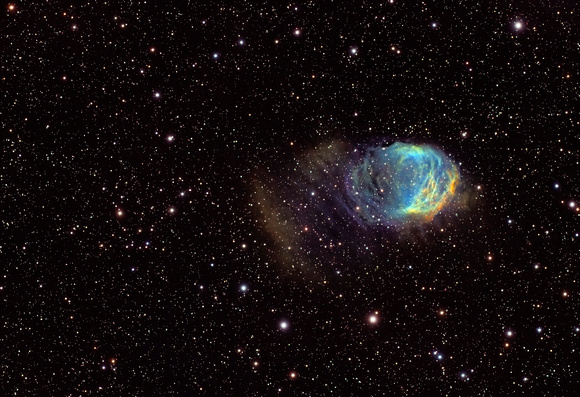The Medusa Deconstructed Planetary Nebula (SHO)
The Medusa Planetary Nebula (Gemini) in HOO and NGC2395 Cluster in RGB
Askar 151phq; AP Mach2 GTO
ASI6200MM, - Baader RGB & 6.5nm NB CMOS opt. filters
H,O,S: (29, 24, 23 x 450s, Bin 1, Gain 200)
R,G,B: (22, 16, 18 x 180s Bin 1, Gain 100) (for stars)
Total integration time = 12.3 hrs
The Medusa Planetary Nebula (PN) (Abell 21 or Sh2-274) was once thought to be a Supernova Remnant (SNR), likely for a couple of reasons. Firstly, for a planetary nebula, energized by the white dwarf leftover from dying star, it is not very bright. Secondly, the structure appears filamentary, more consistent with the form seen in most SNRs – the leftovers of a massive giant star explosion. Since it initial discovery, the white dwarf within the planetary nebula has been identified and appears as a small star in this image – central but towards the brighter RHS of the nebulosity.
While named after the Greek legend whose snake hair turns the viewer to stone, this PN is obviously not made of stone. Rather, it is made of gas buffeted by stellar media winds (and is yet to be fooled into looking into a mirror). The radiation from the central white dwarf is resisting the winds and compressing the gases on the RHS of the PN, while adding to the stellar winds and blowing the PN apart on the LHS. The dimly glowing remains of the planetary nebula’s left hand side can be seen being incorporated into the interstellar media. Thus the planetary nebula is slowly being deconstructed. Ripples caused by the stellar winds are apparently the cause of the “filamentary” structure of the planetary nebula – and are the cause of its initial misidentification. The Medulsa nebula is 1500 ly away and roughly 4 ly in diameter. Other PNs similarly being deconstructed by stellar winds include Sh2-188 – The Shrimp Nebula, Sh2-68 The Flaming Skull Nebula, and ERGB1 The No-Colourful-Name Nebula.
The open cluster – NGC2395 appears to be the Medusa’s companion. It was likely formed by a long spent and dissipated molecular cloud. One reference puts it’s distance at 1660 lys, but it much be much further distant than the Medusa.
This image, while showing the Medusa Nebula in the SHO Hubble Palette, simultaneously shows the stars, including NGC2395 in standard RGB colours.


